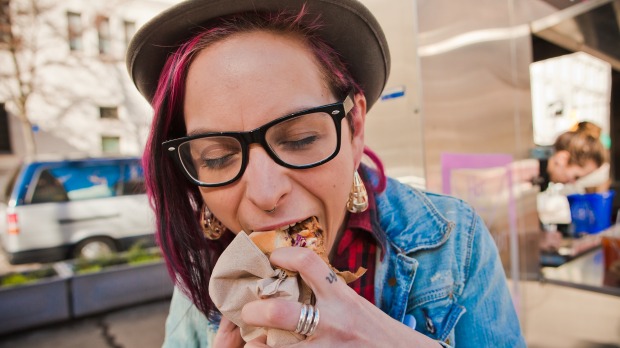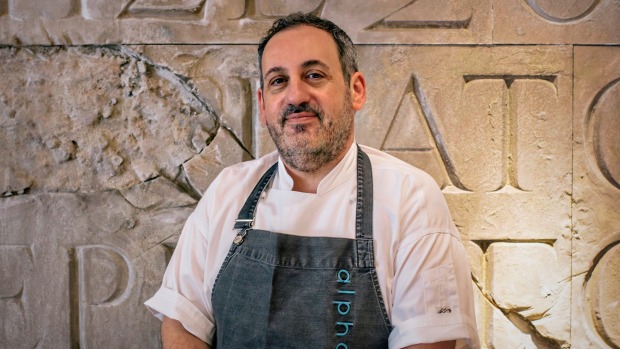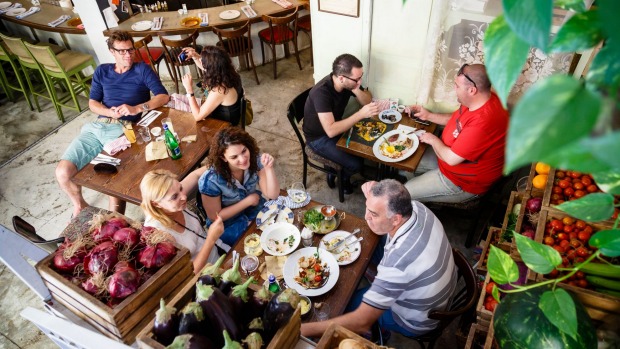Celebrity chef Luke Mangan on his perfect in-flight meal: ocean trout.
This early in the morning, the sun still hanging low over the horizon, nothing disturbs the tranquillity of Macquarie Harbour. It will be a few hours before the handful of shops along Strahan's main street open their doors and tourists start strolling the waterfront.
It is a five-hour drive from here to Hobart, but more than a few visitors add this west coast port on a Tasmanian itinerary. Some come here to explore the dark history of Tasmania's oldest convict settlement, Sarah Island, a place of desperation and despair. Others are drawn by the power of nature, eager to experience the wild majesty of the area's World Heritage listed rainforest.
We have come here for the fish.
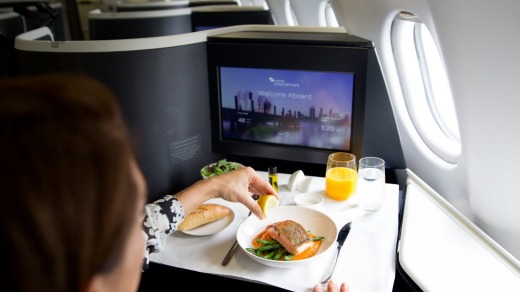
Macquarie Harbour, where the waters of the Franklin-Gordon rivers surge out of the pristine wilderness to meet the Great Southern Ocean, is home to what may be Australia's most famous fish. This is where Petuna Seafoods grows its ocean trout, an ingredient revered by Australia's most acclaimed chefs.
Tetsuya built his signature dish, ocean trout confit, around it; other chefs who love working with it include Mark Best of Marque and Peter Kuruvita of Flying Fish. Luke Mangan not only serves it in his Salt restaurant; he also features it on his business class menus for Virgin Airlines. The fact that such a prestigious product is appearing on airline menus tells you something about the new front in the airline wars.
Around the world, airlines are investing heavily in the food that is served at the front end of the plane. Attracting business class passengers is crucial to the success of any airline; although premium passengers rarely account for more than a third of seats, they are responsible for the majority of an airline's profits.
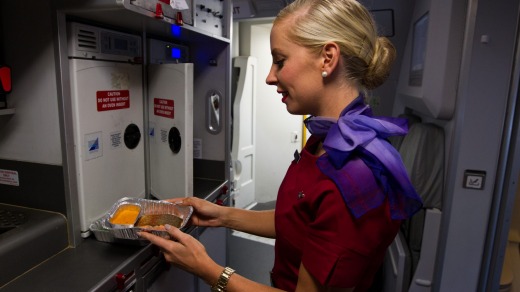
Airlines are therefore always looking for ways to lure to the pointy end. Now that most airlines have invested in flat beds for business class, food is the new front line.
"Food and beverage is massively important for us," says Damon Stanton, Virgin Airlines' manager, in-flight products and service.
"All airlines fly to the same airports. We buy our aircraft from the same companies, we buy our seats from the same companies. Food and beverage, and personal service, are where we can distinguish ourselves."
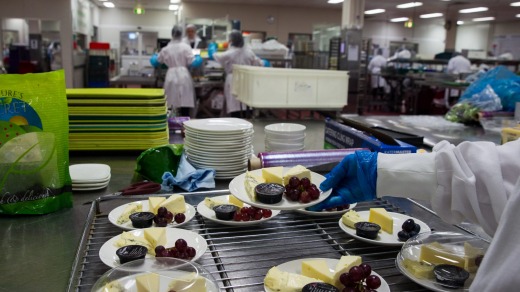
Food has always presented a challenges for airlines, not least because all meals need to be pre-cooked and heated up in flight, which affects both texture and taste. What's more, we lose around 30 per cent of our ability to taste food at altitude – although some economy passengers might snipe that that's no bad thing.
The limitations are greatest in economy, of course. The only way to serve 300 diners at once is to pre-pack meals onto a single tray, and concentrate on mainstream flavours that appeal to most passengers.
It is different in business class, where a higher staff-to-passenger ratio allows meals to be plated individually. The meals themselves feature more interesting ingredients and techniques.
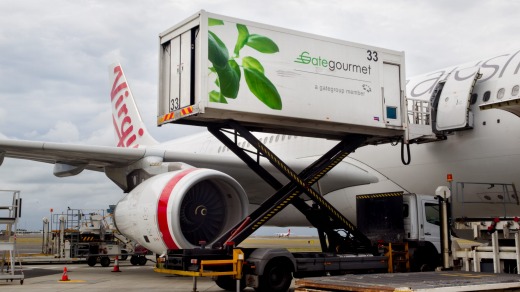
As Stanton says, "Our frequent travellers are eating out several days a week; they are accustomed to sophisticated choices."
Although it seems counter-intuitive, a superior business class service can also build loyalty among economy passengers. Many economy passengers will occasionally use their points to upgrade to business class; if they enjoy the experience, they will be more likely to keep flying that airline.
To boost their culinary credentials, airlines around the world are enlisting the help of celebrity chefs to create tempting business class menus (see box). Qantas has a long-standing relationship with chef Neil Perry, and Virgin works closely with restaurateur and chef Luke Mangan.
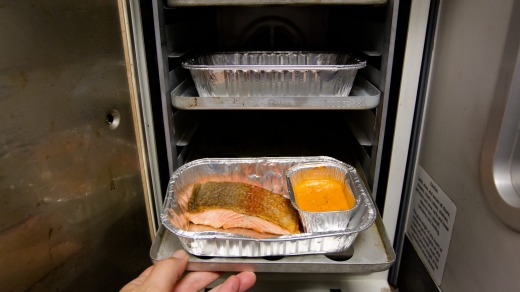
Although Mangan has his own restaurant empire to oversee, with outlets as far afield as Tokyo and the Maldives, he takes his association with Virgin seriously. The test kitchen in Mangan's Sydney headquarters is equipped with an airline oven, to allow Mangan and his team to test new dishes in on-board conditions.
The menu rotation is revamped twice a year, and features six separate menus that are rotated weekly. That means you can fly once a week for six weeks without seeing the same menu. Each menu offers diners a choice of two entrees, three main courses, and a choice of cheese or dessert.
The aim is to create an experience that is as close to dining at a restaurant as possible.
"Any food we have in restaurants, I want in the air," Mangan says. Hence the inclusion of one of Australia's most famous fish on the menu – and our early-morning outing on the waters of Macquarie Harbour.
Our brief is to follow the journey of one airline dish from paddock to plane. In the case of the ocean trout, it all begins here on the Tasmanian west coast.
We are not the only ones interested in the fish this morning. As we cruise up to a pen, we spot a fur seal nearby, scoping out the likelihood of getting in through the mesh protecting the fish. His chances are low: strong mesh is used to protect the valuable livestock, which Petuna's chief executive, Mark Porter, describes as the "Wagyu of the sea".
It is not just the fish's famously velvety texture, created by its high fat content, that has Porter reaching for the metaphor; it is also the way the fish are looked after.
"This is a premium product. We sell 90 per cent of our harvest to high-end restaurants," Porter says. "So we work hard to keep the quality of the trout high. It is akin to the way Wagyu beef are treated: massaged, pampered, not exposed to stress."
Well, almost. No one is about to try massaging a fish. But throughout their lifespan – they spend their first 18 months in fresh waters, then almost as long in the sea water – everything is done to ensure the fish remain at optimum condition, from a high quality diet to very low stock densities.
We visit the farm's compact headquarters, aboard a boat overlooking the pens, where live-aboard staff constantly monitor the fish through underwater cameras, while also keeping an eye on details such as water temperature and salinity.
That same attention to detail is applied during the harvesting process.
"You can grow a fish for three years, and ruin it in the last three minutes of its life," Porter says.
Petuna harvests several times a week, including today. The harvest tanker is massive, large enough to hold two lorries on board. The crew lowers a large hose, known as the elephant's trunk, into the fish pen. It slowly sucks up water, along with the fish, a method considered to be the most humane way to harvest.
"The process is as stress-free as we can make it," Porter says. "The fish goes from being in the water to being on ice in the harvest tanker in 37 seconds."
Once the fish have been harvested, the priority is getting them to the market as quickly as possible. Petuna prides itself on transporting its fish from the ocean to the factory in two hours.
Once the fish have been gutted, they are ferried to the wholesalers. A fish can arrive at the wholesalers on the mainland just 22 hours after it left the water.
From the wholesalers, the fish are sent straight to the airline caterers. Different airports use different caterers; Alpha operates out of Melbourne and Brisbane; Gate Gourmet services Sydney and Darwin. We head to Sydney's Kingsford Smith Airport early one morning to follow the next stage of the journey.
Never having been inside an airport catering complex before, I'm not sure what to expect. I find myself inside a vast hangar, where temperatures are kept low and employees wear white coats, hair nets and overshoes. Although it is still early, the facility is already operating at full speed.
Around the sides of the hangar are delivery docks, cool rooms, kitchens and bakeries, all bustling. In the centre, workers are neatly packaging up economy meals onto trays. Most of them know the routine by heart; however, each work station has an iPad which has a photo of the "gold standard", the meal to which all meals should conform.
Virgin's business class meals are not pre-packaged in the facility. Instead, each element – in this case, that includes the green beans and romesco sauce that are served with the fish – is packaged into preordained portions (120 grams per serve for the ocean trout) to be plated up in-flight.
In-flight plating allows staff to present meals as they might be presented in a restaurant. However, it also has its challenges. To streamline the serving process, the number of elements on the plate has to be considered carefully.
Mangan says balance is the key. "If the sauce is made perfectly, the beans are cooked perfectly and the fish is cooked perfectly, you have a good dish," Mangan says.
In a restaurant, different staff are responsible for plating up and serving. On a plane, the cabin crew must do it all. On each flight, one attendant, designated R1, is responsible for plating up the dishes. These staff require extra training, which is the responsibility of Rachael Vaughan, the food and beverage manager for Luke Mangan at Virgin Airlines.
Vaughan says her job is about more than how to prepare a plate: she ensures that airline staff have a broad range of hospitality skills.
"We do a lot of face-to-face training with the crew," Vaughan says. "We ensure their silver service and plating skills are up scratch, but we also help them with menu terminology, pronunciation of wine, how to describe the dish, what the individual ingredients are."
Having followed the fish this far, it is now time for the final stage of our journey.
On yet another early morning, I head back to the airport, this time to board a flight to Perth. The ocean trout is served on international routes that fly the Boeing777 craft, as well as domestic routes on the Boeing737 and the Airbus A330. Today I'm flying the A330 to Perth, which features Virgin's The Business, a standard-setting business class that includes spacious suites for each passenger.
I'm still settling myself into my new surrounds when a flight attendant comes around with today's menu. The starters offer a choice between Vietnamese chicken salad with toasted cashew, and mushroom soup with porcini and tarragon.
Apart from the ocean trout, the mains include braised short rib with dukkah spiced carrots and broad beans on wasabi mustard and coriander potatoes, and an eggplant and chickpea curry with jasmine rice and Asian herbs. There is also a mesclun salad with a red vinaigrette. Dessert is either a passionfruit meringue roulade or a cheese platter with fruit paste, grapes and crackers.
While I am still musing over my choices, in the kitchen, things are already heating up. There are four ovens operating in the small airplane galley. While many airline ovens operate only on dry heat, Virgin has invested in ovens that can also be set to steam, to help stop the food drying out.
One oven is dedicated to heating the bread; another does the protein; one is reserved for vegetables; the fourth heats the plates. By keeping the components separate, the staff ensure each item is cooked appropriately.
While my meal is being assembled in the kitchen, the flight attendant is setting my place. A white linen tablecloth is spread before me, with silver cutlery and adorable white salt and pepper shakers that remind me of the sails of the Opera House. The plate placed in front of me has the ocean trout carefully placed on a bed of romesco sauce, topped with green beans.
When I start eating, the first thing I notice is the texture. The beans are crisp, the fish flakes apart easily with my fork. I can clearly taste each separate element, the tangy romesco playing off against the fish's rich flavour.
Perhaps even more striking than the food, however, is the rest of the experience. The linen tablecloth. The unhurried – and unprompted – refilling of my glass. The fact that I'm not worried about elbowing my neighbour in the ribs every time I use my knife. The fact that my knife, like the rest of my cutlery, is actually made of metal.
Tastebuds may be dulled in the air, but all our other senses work just fine. And, like a good restaurant meals, this one is a feast for all the senses.
Airlines around the world are calling in high-profile chefs to help boost their culinary credentials. Here's what they are serving up.
STAR POWER: FinnAir has drawn on the talents behind some of Helsinki's top restaurants, including Nokka, G.W. Sundmans, Savoy and Fishmarket.
TYPICAL DISHES: Grilled salmon yuan-yaki with Japanese omelette, cingen sai, simmered burdock root, carrot and steamed rice with wasabi; slow-cooked reindeer entrecote, roasted celeriac and dark sea buckthorn sauce.
STAR POWER: The airline has undertaken a number of partnerships, most recently with the Mandarin Oriental Hotel group, whose chefs designed menus for flights between Hong Kong and London, Paris, New York, San Francisco, Tokyo, and Boston.
TYPICAL DISHES: Confit pork with red wine thyme sauce, orzo pasta, French beans and mushrooms; steamed cod with preserved mustard greens and Chinese olives, served with jasmine rice and choy sum.
STAR POWER: United Airlines had a long partnership with the late Chicago chef Charlie Trotter; today it works with Trotter alumni through the non-profit Trotter Project, developing dishes for premium and economy passengers.
TYPICAL DISHES: Rack of lamb with rosemary jus, Moroccan-seasoned couscous with almonds and sugar snap peas; pumpkin-filled ravioli in a creamy parmesan-pumpkin sauce, bell pepper, sweet potatoes and parmesan cheese.
STAR POWER: The airline's culinary panel features acclaimed chefs from around the world, including France's Georges Blanc, Suzanne Goin from the United States, Yoshihiro Murata of Japan and our own Matt Moran.
TYPICAL DISHES: Steamed Chinese herbal chicken with fine beans and hon shimeji in XO sauce, and mushroom rice; lamb shank with onion, pea-soya beans and tempered Bengal, served with gramm and yoghurt vegetable pilaf.
STAR POWER: Garuda has just recruited some of the country's best known chefs to create Indonesian-inspired dishes for first and business class passengers. The Star Chefs team includes Will Meyrick of Bali's popular Sarong restaurant, and Gilles Marx of Jakarta's Amuz restaurant.
TYPICAL DISHES: Ayam betutu [Balinese grilled chicken] served with long bean yellow coconut and peanut salad; steamed barramundi with ginger rice and lime coconut sauce.
Those pre-packed trays aren't going anywhere, but the good news for those of us flying economy is that meals are slowly improving.
Airlines are getting better at catering to dietary concerns. For example, Virgin's special meal options include diabetic, kosher, halal, Hindu, gluten-free and vegan meals. These must be ordered via the Guest Service Centre at least 48 hours before travel.
If your children are fussy eaters, ask for a children's meal when you book. These menus typically include no-fuss favourites, such as hamburgers and fish fingers.
Multicultural flavours have been adopted by virtually every airline, offering passengers more variety than ever before. However, old habits die hard: Virgin's Damon Stanton says that on flights out of Australia, "anything with beef or lamb, such as braised lamb shoulder or beef bourguignon, tends to be popular."
The trickle-down effect suggests that those steam ovens in business class, which help prevent food from drying out, may eventually make it down to economy. No promises on when, though.
If all else fails, order the dish with the tomato sauce. There's a reason why tomato appears so often on airline menus. "While flying can reduce the sensitivity of our tastebuds by up to 30 per cent, we are still able to taste umami, the so-called fifth taste. Tomato is rich in umami, as are soy sauce and spinach," says Stanton.
